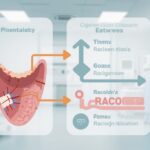Highlights
- Mitapivat, an oral pyruvate kinase activator, demonstrated a 42% haemoglobin response rate in adults with non-transfusion-dependent (NTD) α- or β-thalassaemia compared to 2% with placebo.
- The ENERGIZE phase 3 trial, spanning 18 countries, is the first to show an oral therapy can modify disease in both α- and β-thalassaemia patients without regular transfusions.
- Adverse events were mostly mild or moderate, with no deaths reported, supporting mitapivat’s favourable safety profile.
Study Background and Disease Burden
Non-transfusion-dependent (NTD) thalassaemia encompasses a spectrum of inherited haemoglobin disorders—including α-thalassaemia and β-thalassaemia—characterized by ineffective erythropoiesis and chronic haemolytic anaemia. Patients with NTD thalassaemia typically maintain haemoglobin concentrations at or below 10 g/dL without regular transfusions. Despite this, they face significant morbidity including iron overload, organ dysfunction, osteoporosis, and reduced quality of life. Current management is largely supportive, with no approved oral disease-modifying therapies for β-thalassaemia and none for α-thalassaemia. The need for therapies that address ineffective erythropoiesis, improve anaemia, and reduce complications remains pressing.
Mitapivat is an oral allosteric activator of red cell pyruvate kinase, an enzyme essential for glycolytic ATP production in erythrocytes. By increasing ATP levels, mitapivat is hypothesized to improve red cell survival, reduce haemolysis, and enhance erythropoiesis, addressing the fundamental pathophysiology of both α- and β-thalassaemia.
Study Design
The ENERGIZE trial (ClinicalTrials.gov NCT04770753) is a phase 3, international, randomized, double-blind, placebo-controlled study conducted from November 2021 to March 2023 across 70 sites in 18 countries. Eligible adults (≥18 years) with confirmed NTD α- or β-thalassaemia and baseline haemoglobin ≤10 g/dL were randomized in a 2:1 ratio to receive mitapivat (100 mg orally twice daily) or placebo for 24 weeks. Randomization was stratified by baseline haemoglobin and thalassaemia genotype. The primary endpoint was defined as a mean haemoglobin increase of ≥1.0 g/dL from baseline, sustained from week 12 through week 24. Safety was assessed in all participants receiving at least one dose of study medication. The study included an open-label extension phase.
A total of 235 patients were screened, 194 were randomized (130 to mitapivat, 64 to placebo), and the full analysis set included 130 mitapivat and 64 placebo participants. Safety analyses included 129 mitapivat and 63 placebo recipients due to one patient in each group not initiating treatment.
Key Findings
The primary endpoint was met with statistical significance:
– 42% (55/130) of mitapivat-treated patients achieved a haemoglobin response (≥1.0 g/dL increase) compared to 2% (1/64) in the placebo group (least-squares mean difference 41%, 95% CI 32–50; p<0.0001).
– The haemoglobin increase was sustained across the evaluation period (weeks 12–24), indicating a durable effect.
Adverse events occurred in 83% (107/129) of mitapivat patients and 79% (50/63) of placebo recipients. The most commonly reported events with mitapivat were:
– Headache: 22% (mitapivat) vs 10% (placebo)
– Initial insomnia: 14% vs 5%
– Nausea: 12% vs 8%
– Upper respiratory tract infection: 11% vs 6%
Most adverse events were mild or moderate in severity. There were no deaths during the double-blind treatment period. Seven mitapivat and one placebo patient discontinued treatment before 24 weeks, suggesting a generally acceptable tolerability profile.
Secondary outcomes (not detailed in the abstract) are expected to include measures of fatigue, functional status, and patient-reported outcomes, which are clinically meaningful given the chronic fatigue burden in NTD thalassaemia.
Expert Commentary
The ENERGIZE trial marks a significant advance in the management of NTD thalassaemia. The clear, clinically meaningful increase in haemoglobin and the favourable safety profile position mitapivat as the first potential oral, disease-modifying therapy for both α- and β-thalassaemia patients without regular transfusion requirements. This is especially noteworthy as previous treatments, such as luspatercept, are only approved for transfusion-dependent β-thalassaemia and require parenteral administration.
Mechanistically, targeting erythrocyte metabolism addresses the root cause of anaemia in thalassaemia—ineffective erythropoiesis—rather than merely managing symptoms. This disease-modifying approach is likely to have downstream benefits, potentially reducing iron overload and improving organ function and quality of life. However, long-term data on clinical outcomes, iron parameters, and complication rates are still needed.
Study limitations include the relatively short double-blind period (24 weeks), limited data on long-term safety and efficacy, and the exclusion of paediatric and transfusion-dependent patients. Generalizability may be affected by trial population diversity and comorbidities not fully captured in this summary.
Conclusion
Mitapivat represents a promising new oral therapeutic option for adults with NTD α- or β-thalassaemia, providing robust improvements in haemoglobin and manageable side effects. Pending regulatory approval and further long-term studies, mitapivat may usher in a new era of disease-modifying therapy for these underserved patient populations. Ongoing and future research should address durability of response, impact on quality of life, and long-term safety.
References
Taher AT, Al-Samkari H, Aydinok Y, Besser M, Boscoe AN, Dahlin JL, De Luna G, Estepp JH, Gheuens S, Gilroy KS, Glenthøj A, Sim Goh A, Iyer V, Kattamis A, Loggetto SR, Morris S, Musallam KM, Osman K, Ricchi P, Salido-Fiérrez E, Sheth S, Tai F, Tevich H, Uhlig K, Urbstonaitis R, Viprakasit V, Cappellini MD, Kuo KHM; ENERGIZE investigators. Mitapivat in adults with non-transfusion-dependent α-thalassaemia or β-thalassaemia (ENERGIZE): a phase 3, international, randomised, double-blind, placebo-controlled trial. Lancet. 2025 Jul 5;406(10498):33-42. doi: 10.1016/S0140-6736(25)00635-X. Epub 2025 Jun 19. PMID: 40544857.
Additional literature on thalassaemia management and pyruvate kinase activators can be referenced from:
– Cappellini MD, Musallam KM, Taher AT. Thalassaemia. Lancet. 2022;400(10353):1761-1776.
– Musallam KM, Taher AT, Cappellini MD. Non-transfusion-dependent thalassaemias. Haematologica. 2021;106(7):1862-1869.



